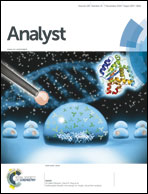Detection of c-reactive protein based on a magnetic immunoassay by using functional magnetic and fluorescent nanoparticles in microplates
Abstract
We report the preparation and application of biofunctional nanoparticles to detect C-reactive protein (CRP) in magnetic microplates. A CRP model biomarker was used to test the proposed detection method. Biofunctional magnetic nanoparticles, CRP, and biofunctional fluorescent nanoparticles were used in a sandwich nanoparticle immunoassay. The CRP concentrations in the samples were deduced from the reference plot, using the fluorescence intensity of the sandwich nanoparticle immunoassay. When biofunctional nanoparticles were used to detect CRP, the detection limit was 1.0 ng ml−1 and the linear range was between 1.18 ng ml−1 and 11.8 μg ml−1. The results revealed that the method involving biofunctional nanoparticles exhibited a lower detection limit and a wider linear range than those of the enzyme-linked immunosorbent assay (ELISA) and most other methods. For CRP measurements of serum samples, the differences between this method and ELISA in CRP measurements of serum samples were less than 13%. The proposed method can reduce the analysis time to one-third that of ELISA. This method demonstrates the potential to replace ELISA for rapidly detecting biomarkers with a low detection limit and a wide dynamic range.


 Please wait while we load your content...
Please wait while we load your content...